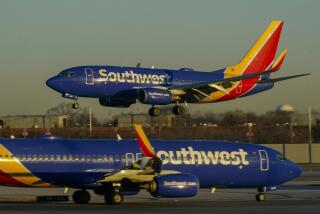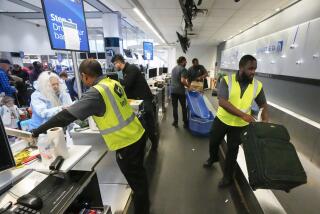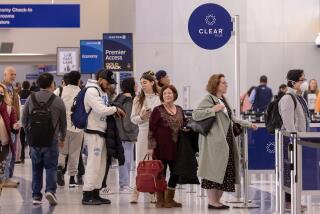The promise of better airline seating may hold an uncomfortable truth
- Share via
You might automatically go into a stupor when the talk turns to legislation involving the Federal Aviation Administration, and no one would blame you. If you had any interest in the recent discussion about the reauthorization act, it probably died when you realized that airline fees would continue to be what they are. Baggage fees, for instance, set a record of $4.5 billion in 2017, and that’s probably not the last record they will set, it seems certain. But what you might have missed is the discussion about airline seat sizes. Is there hope for the cramped?
Maybe. But don’t pop those Champagne corks just yet, even though the FAA Reauthorization 2018 bill was signed Oct. 5.
Here’s that background:
As was the case before the bill was signed, the FAA wants aircraft evacuated in 90 seconds in case of emergency. Our lives may depend on that.
As was also the case before the bill was signed, aircraft seating space has not grown more luxurious in the last few years, which means, in many cases, that we are flying the overfriendly skies.
Seat pitch, which is loosely defined as legroom, is as little as 28 inches on some aircraft. If you’re 12 or younger or if you’re me, which is to say just slightly north of 5 feet, legroom is rarely an issue.
The other hard truth is that Americans are larger than ever. Nearly 40% of Americans are obese, the 2015-2016 statistics from the Centers for Disease Control and Prevention said, up from about 30.5% in 1999-2000.
We also are growing taller, Scientific American reports; people in industrialized nations are about 4 inches taller than they were a century and a half ago.
Couple these things with load factors—the percentage of aircraft seating that is taken—which show that these days, airlines are carrying ever more passengers.
In 2017, domestic flights flew more than 80% full; for these first seven months of 2018, that number is almost 85% and was almost 88% in July, according to the Bureau of Transportation Statistics. That means your prayers that no one sits in the empty middle seat are unlikely to be answered, no matter how fervent your petitions.
Space is at a premium. “Human beings don’t like to be close to one another,” said Samuel Engel, senior vice president at ICF, an aviation consulting business. “You basically have more bodies breathing the same air. From a psychological perspective in Western culture, that makes people uncomfortable.”
But is this a safety issue?
Engel is skeptical that what is safe today will be declared unsafe in the future. “I can’t imagine a government agency taking that position,” he said.
Indeed, the FAA said in a July letter to Paul Hudson, the president of FlightRights.org, that “the FAA has no evidence…that current seat dimensions [width and pitch] hamper the speed of passenger evacuation or that increasing passenger size creates an evacuation issue.”
Economics—the airline’s and yours— could also play a role in how this discussion goes.
Think for a moment about pilots, said Seth Kaplan, managing partner for Airline Weekly, a trade publication. A fuller aircraft means “you get to divide the pilots’ wages among more passengers, so the pilots cost less per passenger,” he said in an email.
“Although airlines do this for their own benefit, not to help consumers, there’s some consumer benefit in the sense that because of simple supply-and-demand economics, fares are a bit lower where there are more seats on the plane.”
“It’s a battle between our backs, our knees and our wallets.”
And who wins the battle of profits versus people? “In terms of profit, airlines are smart companies and will do what’s needed to protect their profits,” said Joe Cortez, the travel expert for NerdWallet, a personal finance website. Hr also sees something a little more insidious: “It’s no secret airlines use decreased seat pitch to sell upgrades for flights,” he said in an emailed statement.
“If the FAA says they have to have less seats, then don’t be surprised if we start seeing an increase in seat selection fees, bag fees or food and beverage costs on flights,” he added in a subsequent email.
Part, but not all, of the solution to that may lie in airline co-branded credit cards, which often will give you a bag free and discounts on food and drink.
The future, as always, is the great unknown. The FAA said in an email that it is “not yet able to comment on how we will implement individual provisions of the reauthorization bill.”
No surprise; it’s been only a little more than two weeks. But in the end, we may be more comfortable, as Cortez suggests, but it also may be that in terms of comfort, we get what we pay for.
Have a travel dilemma or question? Write to [email protected]. We regret we cannot answer every inquiry.
More to Read
Sign up for The Wild
We’ll help you find the best places to hike, bike and run, as well as the perfect silent spots for meditation and yoga.
You may occasionally receive promotional content from the Los Angeles Times.







